Content for TS 23.281 Word version: 19.5.0
1…
5…
6…
7…
7.1.2.3…
7.1.2.4…
7.1.3…
7.2…
7.2.3…
7.3…
7.4…
7.5…
7.6…
7.7…
7.7.1.3.5…
7.7.2…
7.8…
7.17…
7.19…
7.19.3…
7.19.3.1.4…
7.19.3.2…
7.19.3.2.5…
A…
7.4 Video push
7.4.1 General
7.4.2 On-network video push
7.4.2.1 General
7.4.2.2 Information flows for on-network video push
7.4.2.3 One-to-one video push
7.4.2.4 One-to-server video push
7.4.2.5 Remotely initiated video push
7.4.2.6 Remotely initiated video push to group
7.4.3 Off-network video push
7.4.3.1 General
7.4.3.2 Information flows for off-network video push
7.4.3.3 Video push to another MCVideo user
7.4.3.4 Remotely initiated video push
7.4.3.5 Remotely initiated video push to a group
...
...
7.4 Video push p. 95
7.4.1 General p. 95
MCVideo push is enabled in both on-network and off-network mode.
For on-network MCVideo push is supported between MCVideo clients, or between a MCVideo client and a MCVideo server.
For off-network MCVideo push is supported between MCVideo clients only.
7.4.2 On-network video push p. 95
7.4.2.1 General p. 95
A MCVideo user triggers its MCVideo client to push a video to another MCVideo client or a MCVideo server.
A MCVideo user triggers its MCVideo client to trigger a remote video push, i.e. a second MCVideo client pushes a video to a third MCVideo client or to a MCVideo group.
7.4.2.2 Information flows for on-network video push p. 95
The following information flows for private call specified in subclause 7.2.2.2 is used for on-network video push:
- MCVideo private call request (MCVideo client - MCVideo server)
- MCVideo private call request (MCVideo server - MCVideo client)
- MCVideo private call response (MCVideo client - MCVideo server)
- MCVideo private call response (MCVideo server - MCVideo client)
- MCVideo call end request
7.4.2.2.1 Remote video push request p. 95
Table 7.4.2.2.1-1 describes the information flow remote video push request from the MCVideo client to the MCVideo server and from the MCVideo server to the MCVideo client.
| Information element | Status | Description |
|---|---|---|
| MCVideo ID | M | The MCVideo ID of the call originating party. |
| Functional alias | O | The functional alias of the originating party. |
| MCVideo ID | M | The MCVideo ID of the source party who should transmit media. |
| MCVideo ID | O (see Note) | The MCVideo ID of the destination party who should receive media. |
| MCVideo group ID | O (see Note) | The MCVideo group ID of the destination group whose affiliated group members should receive media. |
| SDP offer | O | Media parameters of MCVideo client. |
| Requested commencement mode | O | An indication that is included if the user is requesting a particular commencement mode. |
| Requested priority | O | Application priority level requested for this call. |
|
NOTE:
MCVideo ID information element is present if remote video push to destination user is requested. MCVideo group ID information element is present if remote video push to group is requested.
|
||
7.4.2.2.2 Remote video push response p. 96
Table 7.4.2.2.2-1 describes the information flow remote video push request from the MCVideo server to the MCVideo client and from the MCVideo client to the MCVideo server.
| Information element | Status | Description |
|---|---|---|
| MCVideo ID | M | The MCVideo ID of the call originating party. |
| MCVideo ID | M | The MCVideo ID of the source party who should transmit media. |
| MCVideo ID | O (see Note) | The MCVideo ID of the destination party who should receive media. |
| MCVideo group ID | O (see Note) | The MCVideo group ID of the destination group whose affiliated group members should receive media. |
| Acceptance confirmation | O | An indication whether the user or group members have positively accepted the call. |
| SDP answer | M | Media parameters selected. |
|
NOTE:
MCVideo ID information element is present if remote video push to destination user is requested. MCVideo group ID information element is present if remote video push to group is requested.
|
||
7.4.2.2.3 Remote video push release request p. 96
Table 7.4.2.2.3-1 describes the information flow Remote video push release request from the MCVideo client to the MCVideo server and from the MCVideo server to the MCVideo client.
| Information element | Status | Description |
|---|---|---|
| MCVideo ID | M | The MCVideo ID of the call originating party. |
| MCVideo ID | M | The MCVideo ID of the source party who should transmit media. |
| MCVideo ID | O (see Note) | The MCVideo ID of the destination party who should receive media. |
| MCVideo group ID | O (see Note) | The MCVideo group ID of the destination group whose affiliated group members should receive media. |
|
NOTE:
MCVideo ID information element is present if remote video push to destination user is requested. MCVideo group ID information element is present if remote video push to group is requested.
|
||
7.4.2.2.4 MCVideo push to server request p. 97
Table 7.4.2.2.4-1 describes the information flow MCVideo push to server request from the MCVideo client to the MCVideo server.
| Information element | Status | Description |
|---|---|---|
| MCVideo ID | M | The MCVideo ID of the calling party. |
| Time limit | O | Requested duration of the stream to be recorded. |
| SDP offer | M | Media parameters of MCVideo client. |
| Requested priority | O | Application priority level requested for this call. |
7.4.2.2.5 MCVideo push to server response p. 97
Table 7.4.2.2.5-1 describes the information flow MCVideo push to server response from the MCVideo server to the MCVideo client.
| Information element | Status | Description |
|---|---|---|
| MCVideo ID | M | The MCVideo ID of the calling party. |
| Time limit | O | Accepted or imposed duration limit of the stream to be recorded. |
| File URL | M | URL of the file the stream will be recorded to. |
| SDP answer | M | Media parameters selected. |
7.4.2.2.6 MCVideo push to server complete request p. 97
Table 7.4.2.2.6-1 describes the information flow MCVideo push to server complete request from the MCVideo client to the MCVideo server or from the MCVideo server to the MCVideo client.
| Information element | Status | Description |
|---|---|---|
| MCVideo ID | M | The MCVideo ID of the calling party. |
| Cause | M | End of communication cause. |
7.4.2.2.7 MCVideo push to server complete response p. 98
Table 7.4.2.2.7-1 describes the information flow MCVideo push to server complete response from the MCVideo client to the MCVideo server or from the MCVideo server to the MCVideo client.
| Information element | Status | Description |
|---|---|---|
| MCVideo ID | M | The MCVideo ID of the calling party. |
7.4.2.3 One-to-one video push p. 98
7.4.2.3.1 General p. 98
One-to-one video push is a private call that only allows the calling party to transmit video to the called party, and the private call ends when the video transmission is completed.
7.4.2.3.2 One-to-one video push - call setup p. 98
Procedures in Figure 7.4.2.3.2-1 are the basic signalling control plane procedures for the MCVideo client initiating establishment of MCVideo private call with the chosen MCVideo user for video push.
Pre-conditions:
- This procedure is initiated either manually by the authorized MCVideo users at MCVideo client 1, or automatically due to triggers set by authorized MCVideo users at MCVideo client 1.
- Optionally, MCVideo client 1 may have a functional alias activated to be used.
- The MCVideo server may have subscribed to the MCVideo functional alias controlling server within the MC system for functional alias activation/de-activation updates.
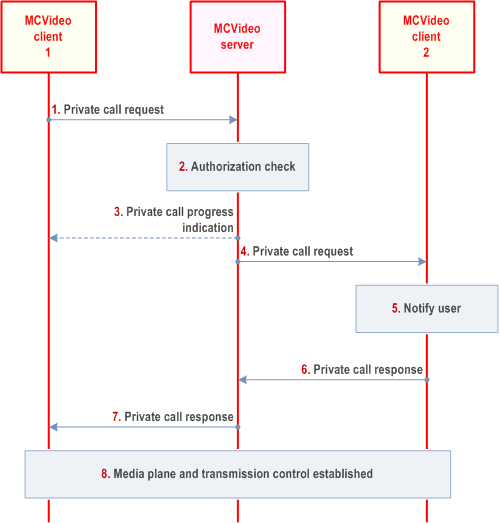
Step 1.
MCVideo client 1 initiates push video to MCVideo client 2, and sends a private call request to the MCVideo server using a service identifier as defined in TS 23.228 for MCVideo, for establishing a private call with the chosen MCVideo user for video push. The MCVideo private call request contains MCVideo ID of invited user, an SDP offer containing one or more media types and the video push indication to indicate that requestor is requesting to transmit video to the called party. The MCVideo user at MCVideo client 1 may include a functional alias used within the MCVideo private call request.
Step 2.
MCVideo server checks whether the MCVideo user at MCVideo client 1 is authorized to initiate the private call for video push, and that MCVideo user at MCVideo client 2 is authorized to receive the private call for video push. MCVideo server verifies whether the provided functional alias, if present, can be used and has been activated for the user.
Step 3.
MCVideo server may provide a progress indication to MCVideo client 1 to indicate progress in the call setup process.
Step 4.
If authorized, MCVideo server includes information that it communicates using MCVideo service, offers the same media types or a subset of the media types contained in the initial received request, includes the requested automatic commencement mode indication based on a requested commencement mode by the calling user or based upon the setting of the called MCVideo client and sends the corresponding MCVideo private call request towards the MCVideo client 2, including the MCVideo ID and, if available the functional alias of the calling MCVideo user 1. If the called MCVideo user has registered to the MCVideo service with multiple MCVideo UEs and has designated the MCVideo UE for receiving the private calls, then the incoming MCVideo private call request is delivered only to the designated MCVideo UE.
Step 5.
The MCVideo client 2 notifies the user about the incoming private call for video push. If the functional alias of the calling user is included it is displayed.
Step 6.
The MCVideo client 2 accepts the private call for video push, and sends an MCVideo private call response to the MCVideo server.
Step 7.
Upon receiving the MCVideo private call response from MCVideo client 2 accepting the private call request for video push, the MCVideo server informs the MCVideo client 1 about successful call establishment via a private call response message.
Step 8.
MCVideo client 1 and MCVideo client 2 have successfully established media plane and transmission control for media communication.
7.4.2.3.3 One-to-one video push - call release p. 99
The private call release procedure specified in subclause 7.2.2.3.3 is used for one-to-one video push call release.
7.4.2.4 One-to-server video push p. 99
7.4.2.4.1 General p. 99
One-to-server video push is a private call between the calling party and the MCVideo server that allows the calling party to transmit video to the server for it to be recorded to a file. The one-to-server video push ends when the video transmission is stopped by the calling party or by the MCVideo server.
7.4.2.4.2 Procedure p. 99
Procedure in Figure 7.4.2.4.2-1 is the basic signalling control plane procedures for the MCVideo client initiating establishment of MCVideo video push to the MCVideo server.
Pre-conditions:
- MCVideo user 1 on MCVideo client 1 has been authenticated and authorized to use MCVideo service.
- MCVideo client 1 is registered.
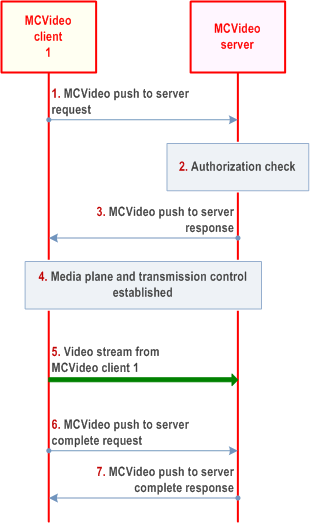
Step 1.
MCVideo user on MCVideo client 1 initiates the push of a video to the server and sends an MCVideo push to server request to the MCVideo server. The request contains an SDP offer with media.
Step 2.
MCVideo server checks whether MCVideo client 1 is authorized to push a video to the server.
Step 3.
MCVideo server accepts the push to server request and sends an MCVideo push to server response. The response contains the SDP answer and the URL of the file where the video stream will be recorded.
Step 4.
MCVideo client 1 and MCVideo server have successfully established the media plane and transmission control for the video stream.
Step 5.
Video stream is transmitted from MCVideo client 1 to MCVideo server. The MCVideo server records the stream to the file whose URL has been given in the MCVideo push to server response.
Step 6.
MCVideo user on MCVideo client 1, or MCVideo client 1 based on pre-defined criteria (e.g. duration), stops the video push to the server and sends an MCVideo push to server complete request.
Step 7.
MCVideo server acknowledges the end of the communication.
7.4.2.5 Remotely initiated video push p. 101
7.4.2.5.1 General p. 101
Remotely initiated video push is a private call remotely initiated by a user that only allows a source user to transmit video to a destination, and the private call ends when the video transmission is completed or released by the authorized user who remotely initiated video push call.
7.4.2.5.2 Remotely initiated video push - call setup p. 101
The procedure describes the case where an authorized MCVideo user is initiating an remotely initiated video push call from source MCVideo user to a destination MCVideo user. Only the source user is allowed to transmit video to the destination user.
Procedures in Figure 7.4.2.5.2-1 are the basic signalling control plane procedures for the MCVideo client remotely initiating establishment of MCVideo private call between the source and destination MCVideo users.
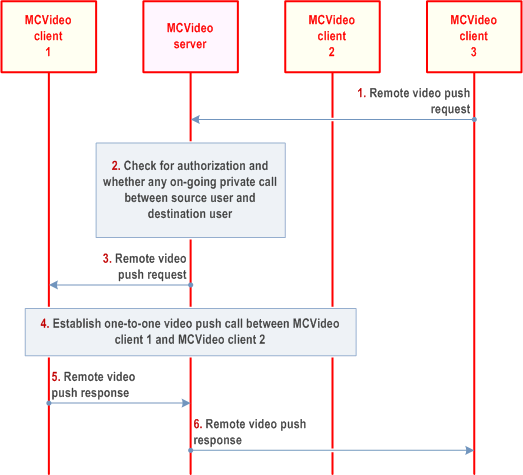
Step 1.
MCVideo user on MCVideo client 3 initiates remote video push from MCVideo client 1 to MCVideo client 2, by sending a remote video push request to the MCVideo server for establishing a one-to-one video push call between MCVideo client 1 and MCVideo client 2. The remote video push call request contains MCVideo ID of source (MCVideo client 1) and destination (MCVideo client 2) users.
Step 2.
MCVideo server checks whether the MCVideo user at MCVideo client 3 is authorized to remotely initiate video push call between the source user and the destination user. MCVideo server also checks if there is any on-going call between the source user and the destination user.
Step 3.
If MCVideo client 3 is authorized and there is no on-ongoing private call between source user and destination user, the MCVideo server sends the remote video push request message to MCVideo client 1 including the information of MCVideo ID of source and destination users.
Step 4.
The MCVideo client 1 accepts the remote video push request and establishes a one-to-one video push call between MCVideo client 1 and MCVideo client 2 as described in the subclause 7.4.2.3.2. The video is transmitted from MCVideo client 1 to MCVideo Client 2.
Step 5.
The MCVideo client 1 sends a remote video push response message to MCVideo server indicating success or failure of call establishment between MCVideo client 1 and MCVideo client 2.
Step 6.
Upon receiving the remote video push response from MCVideo client 1, the MCVideo server informs the MCVideo client 3 about success or failure of the call establishment by sending a remote video push response message.
7.4.2.5.3 Remotely initiated video push - call release by authorized user p. 102
The procedure describes the case where an authorized MCVideo user is releasing an remotely initiated video push call.
Procedures in Figure 7.4.2.5.3-1 are the basic signalling control plane procedures for the MCVideo client releasing the remotely initiated video push call between the source and destination users.
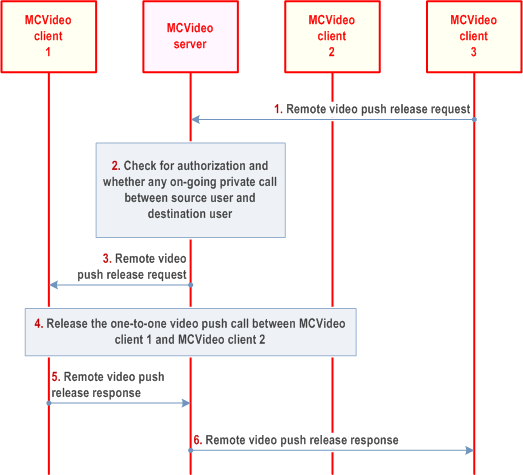
Step 1.
MCVideo user on MCVideo client 3 initiates release of remotely initiated video push call between MCVideo client 1 and MCVideo client 2, by sending a remote video push release request to the MCVideo server for releasing a one-to-one video push call between MCVideo client 1 and MCVideo client 2. The remote video push release request contains MCVideo ID of source user (MCVideo client 1) and destination user (MCVideo client 2).
Step 2.
MCVideo server checks whether the MCVideo user at MCVideo client 3 is authorized to release the remotely initiated video push call between MCVideo client 1 and MCVideo client 2, and whether there is any on-going one-to-one video push call between MCVideo client 1 and MCVideo client 2.
Step 3.
MCVideo server sends the remote video push release request to MCVideo client 1 for releasing the on-going one-to-one video push call between MCVideo client 1 and MCVideo client 2.
Step 4.
The MCVideo client 1 accepts the remote video push release request and performs the release procedure for the one-to-one video push call between MCVideo client 1 and MCVideo client 2 as described in the subclause 7.4.2.3.3.
Step 5.
The MCVideo client 1 sends a remote video push release response to the MCVideo server indicating the release of the one-to-one video push call between MCVideo client 1 and MCVideo client 2.
Step 6.
Upon receiving the remote video push release response from MCVideo client 1, the MCVideo server informs the MCVideo client 3 about the one-to-one video push call release by sending a remote video push release response message.
7.4.2.6 Remotely initiated video push to group p. 103
7.4.2.6.1 General p. 103
Remotely initiated video push to group is a type of broadcast group call that only allows the originating user to remotely request a source user to transmit video to the group, and the group call ends when the video transmission is completed or the authorized user releases the remotely initiated video push to group call.
7.4.2.6.2 Remotely initiated video push to group - call setup p. 103
The procedure describes the case where an authorized MCVideo user is initiating video push to group call for transmitting video from a source MCVideo user to the group. Only the source MCVideo user is allowed to transmit video.
Procedures in Figure 7.4.2.6.2-1 are the basic signalling control plane procedures for the MCVideo client remotely initiating a video push to group call.
Pre-conditions:
- MCVideo client 1 and MCVideo client 2 are affiliated members of the group X.
- The user on MCVideo client 1 is authorized to remotely initiate a video push to group call to enable transmitting the video from the user on MCVideo client 2.
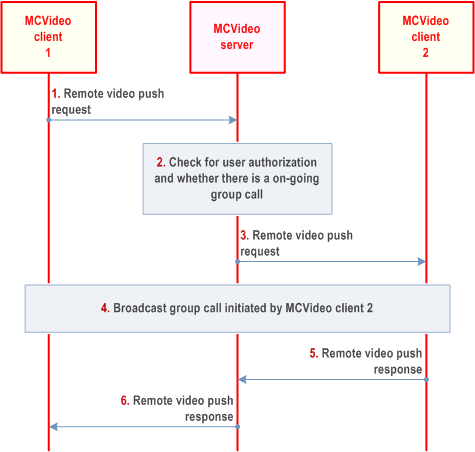
Step 1.
MCVideo user on MCVideo client 1 remotely initiates a video push to group from MCVideo client 2, by sending a remote video push request to the MCVideo server. The remote video push request contains MCVideo ID of the source user (user of MCVideo client 2) and the MCVideo group ID of the group X to which the video transmission is requested.
Step 2.
MCVideo server checks whether the MCVideo user at MCVideo client 1 is authorized to remotely initiate a video push to group, and also checks whether MCVideo client 2 is transmitting video in any on-going MCVideo group call on group X. If MCVideo client 2 is already transmitting video to group X then a suitable response is provided in step 6 to MCVideo client 1.
Step 3.
The MCVideo server sends a remote video push request initiated by MCVideo client 1 to MCVideo client 2. The remote video push request contains MCVideo ID of the source user, the MCVideo group ID of the group X to which the video transmission is to be initiated by the source user and an SDP offer containing one or more media types.
Step 4.
MCVideo client 2 initiates a MCVideo broadcast group call on group X. The MCVideo client 2 begins to transmit video to the group X.
Step 5.
The MCVideo client 2 sends a remote video push response message to MCVideo server indicating success or failure in remotely initiating the video push to group X.
Step 6.
The MCVideo server sends a remote video push response message to MCVideo client 1 indicating success or failure in remotely initiating the video push to group X by the MCVideo client 2.
7.4.2.6.3 Remotely initiated video push to group - call release by authorized user p. 104
The procedure describes the case where an MCVideo user is remotely releasing a video push to group call for ending the video transmission from the source MCVideo user.
Procedures in Figure 7.4.2.6.3-1 are the basic signalling control plane procedures for the MCVideo client remotely releasing a video push to group call.
Pre-condition:
- MCVideo client 1 and MCVideo client 2 are affiliated members of the group X and there is an on-going broadcast group call on group X from MCVideo client 2 remotely initiated by MCVideo client 1 as described in subclause 7.4.2.6.2.
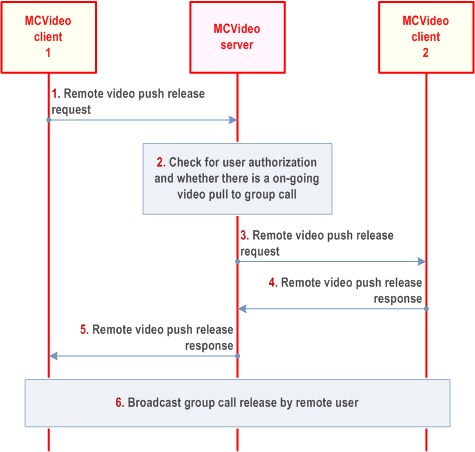
Step 1.
MCVideo user on MCVideo client 1 remotely initiates a release of the video push to group call from MCVideo client 2, by sending a remote video push release request to the MCVideo server. The remote video push release request contains MCVideo ID of the source user (user of MCVideo client 2) and the MCVideo group ID of the group X to which the video transmission is to be released.
Step 2.
MCVideo server checks whether the MCVideo user at MCVideo client 1 is authorized to remotely release a video push to group call, and also checks whether MCVideo client 2 is transmitting video in an on-going MCVideo group call on group X remotely initiated by MCVideo client 1. If MCVideo client 2 is not transmitting video on group X then a suitable response is provided in step 5 to MCVideo client 1.
Step 3.
The MCVideo server sends a remote video push release request initiated by MCVideo client 1 to MCVideo client 2. The remote video push release request contains MCVideo ID of the source user, the MCVideo group ID of the group X to which the video transmission is to be released.
Step 4.
The MCVideo client 2 sends a remote video push release response message to MCVideo server indicating the release of video push to group call.
Step 5.
The MCVideo server sends a remote video push release response message to MCVideo client 1 indicating the release of video push to group call.
Step 6.
MCVideo client 2 stops the video transmission to the group X and releases the MCVideo broadcast group call on group X remotely initiated by MCVideo client 1.
7.4.3 Off-network video push p. 105
7.4.3.1 General p. 105
A MCVideo user triggers its MCVideo client to push a video to another MCVideo client.
A MCVideo user triggers its MCVideo client to trigger a remote video push, which requests a second MCVideo client to push a video to a third MCVideo client or to a MCVideo group.
Off-network remote video push works without involving the network.
Off-network video push communications are based on ProSe capabilities as described in clause 7.18.
7.4.3.2 Information flows for off-network video push p. 105
7.4.3.2.1 Remote video push request p. 105
Table 7.4.3.2.1-1 describes the information flow for the remote video push request sent from one MCVideo client to other MCVideo client(s).
| Information element | Status | Description |
|---|---|---|
| MCVideo ID | M | The identity of the MCVideo user remotely requesting the video push. |
| MCVideo ID | M | The identity of the MCVideo user from whom the video push is requested. |
| Video information | O | Information identifying the video. |
| MCVideo group ID | O | The MCVideo group ID to which the video is to be transmitted. |
7.4.3.2.2 Video push trying response p. 105
Table 7.4.3.2.2-1 describes the information flow for the video push trying response sent from one MCVideo client to another MCVideo client.
| Information element | Status | Description |
|---|---|---|
| MCVideo ID | M | The identity of the MCVideo user sending the trying response. |
| MCVideo ID | M | The identity of the MCVideo user to whom the trying response is sent. |
| MCVideo ID | M | The identity of the MCVideo user to whom the video is attempted. |
7.4.3.2.3 Notification of video push p. 105
Table 7.4.3.2.3-1 describes the information flow for the notification of video push sent from one MCVideo client to another MCVideo client.
| Information element | Status | Description |
|---|---|---|
| MCVideo ID | M | The identity of the MCVideo user sending the notification. |
| MCVideo ID | M | The identity of the MCVideo user to whom the notification is sent. |
| MCVideo ID | M | The identity of the MCVideo user to whom the video is pushed. |
7.4.3.3 Video push to another MCVideo user p. 106
7.4.3.3.1 General p. 106
The MCVideo Push is the capability of a MCVideo user to push a video to another MCVideo user. A MCVideo user can push a video which is:
- being received by the MCVideo user from another a MCVideo client; or
- being recorded live on the MCVideo client.
7.4.3.3.2 Procedure p. 106
Figure 7.4.3.3.2-1 describes procedures for an off-network MCVideo video push, inititated by MCVideo client B with another MCVideo client C, to push a video received from MCVideo client A to MCVideo client C.
MCVideo client A or MCVideo client C or both can be autonomous MCVideo clients or can be human controlled MCVideo clients. In any such combination, following the procedure is followed.
MCVideo client A and MCVideo client B may belong to the same MCVideo user.
Pre-conditions:
- MCVideo client A and MCVideo client B are engaged in MCVideo communication, where MCVideo client B is receiving media from MCVideo client A.
- MCVideo user B has initiated MCVideo video push with MCVideo user C.
- MCVideo client B and MCVideo client C are members of the same ProSe Discovery group and are ProSe 1:1 direct communication capable.
- MCVideo client B has discovered MCVideo client C in proximity, associated with MCVideo user C, using ProSe Discovery procedures.

Step 1.
The MCVideo client B sends a Private communication request towards MCVideo client C. The Private communication request indicates that the request is for video push and contains the SDP offer.
Step 2a.
The MCVideo client C may notify the MCVideo user C about the MCVideo Push request (if the MCVideo client C is human controlled)
Step 2b.
The MCVideo client C automatically accepts the Private communication request for video push and sends a Private communication answer response to MCVideo client B. The Private communication answer response contains SDP answer.
Step 3a.
If configured, the MCVideo client B notifies MCVideo client A about the video being pushed to MCVideo client C by sending a notification message to MCVideo client A.
Step 3b.
If configured, the MCVideo client A may notify the MCVideo user A about the video being pushed to MCVideo client C.
Step 4.
The MCVideo client B and MCVideo client C establish the media plane for communication.
Step 5.
Video being received by MCVideo client B from MCVideo client A is transmitted from MCVideo client B to MCVideo client C and presented to the MCVideo user C.
7.4.3.4 Remotely initiated video push p. 107
7.4.3.4.1 General p. 107
The MCVideo push is the capability of a MCVideo user to push a video from a second MCVideo user to a third MCVideo user.
7.4.3.4.2 Procedure p. 107
Figure 7.4.3.4.2-1 describes procedures for a remotely initiated off-network MCVideo video push, inititated by MCVideo user A at MCVideo client A with another MCVideo client B, to push a video to MCVideo client C.
MCVideo client B can be an autonomous MCVideo client or can be a human controlled MCVideo client. In either case, following procedure is followed.
Pre-conditions:
- MCVideo user A has remotely initiated MCVideo video push with MCVideo user B.
- MCVideo client A and MCVideo client B are members of the same ProSe Discovery group and are ProSe 1:1 direct communication capable.
- MCVideo client A has discovered MCVideo client B in proximity, associated with MCVideo user B, using ProSe Discovery procedures.
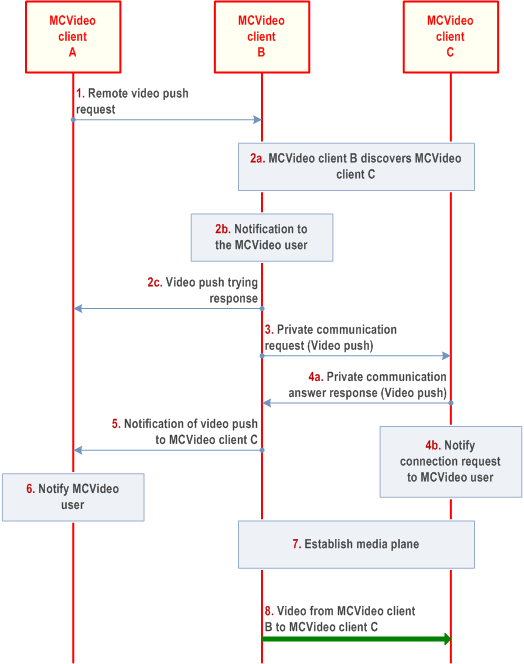
Step 1.
The MCVideo client A sends a Video push request towards the MCVideo client B. The Video push request indicates MCVideo client C as the intended recipient.
Step 2a.
The MCVideo client B checks whether there is on-going priviate communication with MCVideo client C. If there is on-going private communication with MCVideo client C, then step 3, step 4 and step 5 are skipped, else MCVideo client B enables ProSe layer to discover MCVideo client C as specified in subclause 7.2.3.
Step 2b.
The MCVideo client B notifies the MCVideo user B about the incoming Video push request (if MCVideo client B is human controlled).
Step 2c.
The MCVideo client B sends a video push trying response to MCVideo client A indicating that it is attempting to establish a connection with MCVideo client C,
Step 3.
Once the required details of MCVideo client C are obtained (either by discovery or from MCVideo client A) the MCVideo client B accepts the Video push request, and sends a Private communication request to MCVideo client C. The Private communication request indicates that the request was in response to the video push request from the MCVideo client A. The Private communication request contains the SDP offer.
Step 4a.
MCVideo client C sends a Private communication answer response to MCVideo client B in response to the Private communication request. The Private communication answer response contains the SDP answer.
Step 4b.
The MCVideo client C notifies MCVideo user C about the incoming Private communication request as an indication of incoming video.
Step 5.
Upon receiving a Private communication answer response from the MCVideo client C, the MCVideo client B sends a notification message to the MCVideo client A indicating that MCVideo client C has accepted the request.
Step 6.
MCVideo client A notifies the MCVideo user A about the acceptance of the request by MCVideo client C (if the MCVideo client A is human controlled)
Step 7.
The MCVideo client B and the MCVideo client C establish the media plane for communication.
Step 8.
Media is transmitted from MCVideo client B to MCVideo client C and presented to the MCVideo user C.
7.4.3.5 Remotely initiated video push to a group p. 109
7.4.3.5.1 General p. 109
The MCVideo push is the capability of a MCVideo user to push a video from a second MCVideo user to a MCVideo group.
7.4.3.5.2 Procedure p. 109
Figure 7.4.3.5.2-1 describes procedures for an off-network remote video push request, initiated by MCVideo user A at MCVideo client A towards a MCVideo client B, to initiate a video push to MCVideo group G.
MCVideo client B can be an autonomous MCVideo client or can be a human controlled MCVideo client. In either case, following procedure should be followed.
Pre-conditions:
- MCVideo client A and MCVideo client B are members of MCVideo group G.
- MCVideo user A has initiated remote video push request with MCVideo user B to initiate a video push to MCVideo group G.
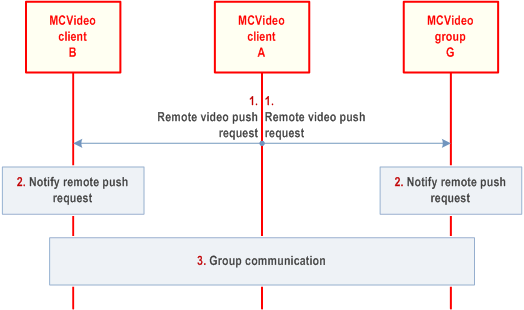
Step 1.
MCVideo client A sends a remote video push request towards the MCVideo group. The remote video push request indicates MCVideo client B as the intended target of the request and MCVideo group G as the intended recipient.
Step 2.
Upon receiving the remote video push request as the intended target of the request, the MCVideo client B notifies the MCVideo user B of the remote video push request, if the MCVideo client B is human controlled. Other MCVideo group members notify their respective MCVideo users of the remote video push request.
Step 3.
The MCVideo client B automatically accepts the remote video push request and sends a group communication announcement message with video push indication towards the MCVideo group, as described in subclause 7.1.3.3. The group communication announcement message contains an SDP body and an indication that the group communication announcement is for video push.